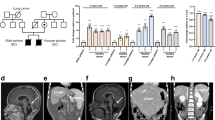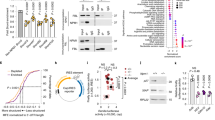Abstract
Mutations in the human telomerase RNA component (hTR), the telomerase ribonucleoprotein component dyskerin (DKC1) and the poly(A) RNase (PARN) can lead to reduced levels of hTR and to dyskeratosis congenita (DC). However, the enzymes and mechanisms responsible for hTR degradation are unknown. We demonstrate that defects in dyskerin binding lead to hTR degradation by PAPD5-mediated oligoadenylation, which promotes 3′-to-5′ degradation by EXOSC10, as well as decapping and 5′-to-3′ decay by the cytoplasmic DCP2 and XRN1 enzymes. PARN increased hTR levels by deadenylating hTR, thereby limiting its degradation by EXOSC10. Telomerase activity and proper hTR localization in dyskerin- or PARN-deficient cells were rescued by knockdown of DCP2 and/or EXOSC10. Prevention of hTR RNA decay also led to a rescue of localization of DC-associated hTR mutants. These results suggest that inhibition of RNA decay pathways might be a useful therapy for some telomere pathologies.
This is a preview of subscription content, access via your institution
Access options
Subscribe to this journal
Receive 12 print issues and online access
$189.00 per year
only $15.75 per issue
Buy this article
- Purchase on Springer Link
- Instant access to full article PDF
Prices may be subject to local taxes which are calculated during checkout






Similar content being viewed by others
References
Blackburn, E.H. & Collins, K. Telomerase: an RNP enzyme synthesizes DNA. Cold Spring Harb. Perspect. Biol. 3, a003558 (2011).
Armanios, M. & Blackburn, E.H. The telomere syndromes. Nat. Rev. Genet. 13, 693–704 (2012).
Heiss, N.S. et al. X-linked dyskeratosis congenita is caused by mutations in a highly conserved gene with putative nucleolar functions. Nat. Genet. 19, 32–38 (1998).
Vulliamy, T. et al. The RNA component of telomerase is mutated in autosomal dominant dyskeratosis congenita. Nature 413, 432–435 (2001).
Mitchell, J.R., Wood, E. & Collins, K. A telomerase component is defective in the human disease dyskeratosis congenita. Nature 402, 551–555 (1999).
Vulliamy, T.J. & Dokal, I. Dyskeratosis congenita: the diverse clinical presentation of mutations in the telomerase complex. Biochimie 90, 122–130 (2008).
Stuart, B.D. et al. Exome sequencing links mutations in PARN and RTEL1 with familial pulmonary fibrosis and telomere shortening. Nat. Genet. 47, 512–517 (2015).
Dhanraj, S. et al. Bone marrow failure and developmental delay caused by mutations in poly(A)-specific ribonuclease (PARN). J. Med. Genet. 52, 738–748 (2015).
Tummala, H. et al. Poly(A)-specific ribonuclease deficiency impacts telomere biology and causes dyskeratosis congenita. J. Clin. Invest. 125, 2151–2160 (2015).
Rammelt, C., Bilen, B., Zavolan, M. & Keller, W. PAPD5, a noncanonical poly(A) polymerase with an unusual RNA-binding motif. RNA 17, 1737–1746 (2011).
Vanácová, S. et al. A new yeast poly(A) polymerase complex involved in RNA quality control. PLoS Biol. 3, e189 (2005).
Wyers, F. et al. Cryptic pol II transcripts are degraded by a nuclear quality control pathway involving a new poly(A) polymerase. Cell 121, 725–737 (2005).
Kadaba, S. et al. Nuclear surveillance and degradation of hypomodified initiator tRNAMet in S. cerevisiae. Genes Dev. 18, 1227–1240 (2004).
LaCava, J. et al. RNA degradation by the exosome is promoted by a nuclear polyadenylation complex. Cell 121, 713–724 (2005).
Goldfarb, K.C. & Cech, T.R. 3′ terminal diversity of MRP RNA and other human noncoding RNAs revealed by deep sequencing. BMC Mol. Biol. 14, 23 (2013).
Fu, D. & Collins, K. Distinct biogenesis pathways for human telomerase RNA and H/ACA small nucleolar RNAs. Mol. Cell 11, 1361–1372 (2003).
Ueda, Y. et al. A mutation in the H/ACA box of telomerase RNA component gene (TERC) in a young patient with myelodysplastic syndrome. BMC Med. Genet. 15, 68 (2014).
Cohen, S.B. & Reddel, R.R. A sensitive direct human telomerase activity assay. Nat. Methods 5, 355–360 (2008).
Zhu, Y., Tomlinson, R.L., Lukowiak, A.A., Terns, R.M. & Terns, M.P. Telomerase RNA accumulates in Cajal bodies in human cancer cells. Mol. Biol. Cell 15, 81–90 (2004).
Tomlinson, R.L., Ziegler, T.D., Supakorndej, T., Terns, R.M. & Terns, M.P. Cell cycle-regulated trafficking of human telomerase to telomeres. Mol. Biol. Cell 17, 955–965 (2006).
Venteicher, A.S. et al. A human telomerase holoenzyme protein required for Cajal body localization and telomere synthesis. Science 323, 644–648 (2009).
Zhong, F.L. et al. TPP1 OB-fold domain controls telomere maintenance by recruiting telomerase to chromosome ends. Cell 150, 481–494 (2012).
Tseng, C.-K.K. Human telomerase RNA processing and quality control. Cell Reports 13, 2232–2243 (2015).
Nguyen, D. et al. A polyadenylation-dependent 3′ end maturation pathway is required for the synthesis of the human telomerase RNA. Cell Rep, 13, 2244–2257 (2015).
Moon, D.H. et al. Poly(A)-specific ribonuclease (PARN) mediates 3′-end maturation of the telomerase RNA component. Nat. Genet. 47, 1482–1488 (2015).
Shukla, S. & Parker, R. Quality control of assembly-defective U1 snRNAs by decapping and 5′-to-3′ exonucleolytic digestion. Proc. Natl. Acad. Sci. USA 111, E3277–E3286 (2014).
Teixeira, M.T., Forstemann, K., Gasser, S.M. & Lingner, J. Intracellular trafficking of yeast telomerase components. EMBO Rep. 3, 652–659 (2002).
Gallardo, F., Olivier, C., Dandjinou, A.T., Wellinger, R.J. & Chartrand, P. TLC1 RNA nucleo-cytoplasmic trafficking links telomerase biogenesis to its recruitment to telomeres. EMBO J. 27, 748–757 (2008).
Xi, L. & Cech, T.R. Inventory of telomerase components in human cells reveals multiple subpopulations of hTR and hTERT. Nucleic Acids Res. 42, 8565–8577 (2014).
Abreu, E., Terns, R.M. & Terns, M.P. Visualization of human telomerase localization by fluorescence microscopy techniques. Methods Mol. Biol. 735, 125–137 (2011).
Schmidt, J.C., Dalby, A.B. & Cech, T.R. Identification of human TERT elements necessary for telomerase recruitment to telomeres. eLife 3, e03563 (2014).
Stern, J.L., Theodorescu, D., Vogelstein, B., Papadopoulos, N. & Cech, T.R. Mutation of the TERT promoter, switch to active chromatin, and monoallelic TERT expression in multiple cancers. Genes Dev. 29, 2219–2224 (2015).
Acknowledgements
We would like to thank A. Zaug for his assistance with the telomerase direct activity assays; A. Webb for help with the illustrations and figures in this manuscript; S. Spencer (University of Colorado Boulder), J. Lingner (Institut Suisse de Recherche Expérimentale sur le Cancer) and S.B. Cohen (Children's Medical Research Institute) for providing materials; and members of the Parker and Cech laboratories for their comments and suggestions. J.C.S. is supported as a Merck fellow of the Damon Runyon Cancer Research Foundation (DRG-2169-13). This work was supported by US National Institutes of Health grants R01 GM45443 (R.P.) and GM099705 (T.R.C.). T.R.C. and R.P. are supported as investigators of the Howard Hughes Medical Institute.
Author information
Authors and Affiliations
Contributions
S.S., J.C.S., T.R.C. and R.P. conceptualized and designed the experiments. S.S. performed the experiments. J.C.S. performed the Pol II ChIP for hTR. K.C.G. and S.S. analyzed the hTR 3′-end sequencing reads. S.S., J.C.S., T.R.C. and R.P. analyzed and interpreted data. S.S., J.C.S., T.R.C. and R.P. wrote the manuscript.
Corresponding author
Ethics declarations
Competing interests
T.R.C. is on the board of directors of Merck, Inc. The other authors declare no competing financial interests.
Integrated supplementary information
Supplementary Figure 1 Quality-control pathways for A377G and C408G mutant hTR are conserved in U2OS cells.
Knockdown of specific nucleases rescues levels of A377G and C408G hTR in U2OS cells. a, Western blot for knockdown of various nucleases in U2OS cells. b, Northern blot for A377G hTR levels upon knockdown of DCP2, EXOSC10 or XRN1 (mean+/-s.d., n=4 independent experiments). c, Northern blot for C408G hTR levels upon PAPD5 knockdown with or without a co-knockdown of DCP2 or XRN1 (mean+/-s.d., n=3 independent experiments). d, Northern blot for C408G hTR upon co-knockdown of EXOSC10 and PAPD5 (mean+/-s.d., n=4 independent experiments). e, Northern blot for hTR upon knockdown of various decapping enzymes in U2OS cells (mean+/-s.d., n=4 independent experiments). f, Normalized Pol II occupancy by ChIP for the wild-type and C408G hTR plasmid-borne copy in U2OS cells (wild-type arbitrarily set to 1 and C408G normalized to wild-type).
Supplementary Figure 2 hTR 3′ mature end exhibits longer A tails after PARN knockdown.
Length distribution of oligo(A) tails at the mature 3’ end of hTR under different transfection conditions. Relative amount of each two or more A-containing reads was calculated to the total number of two or more A’s containing hTR reads under each transfection condition (P<0.05 by one tail unpaired Student’s t test).
Supplementary Figure 3 Mutant hTR localizes to cyTER bodies in U2OS cells.
Mutant A377G or C408G hTR is mislocalized to the cytoplasm in cyTER bodies in U2OS cells. a, Cytoplasmic localization of A377G or C408G RNA (white arrowheads) by FISH in U2OS cells. The nucleus is labeled with an antibody that recognizes either of the nuclear envelope components lamin A or lamin C (Scale bar 5 μm). White numbers in Merge, % of cells showing hTR localization to Cajal bodies (mean+/-s.d., n=4 independent experiments). b, Cytoplasmic localization of C408G hTR by FISH (nucleus outlined with lamin A/C staining, cell outlined with pan cadherin staining) (Scale bar 5 μm). White numbers in Merge, % of cells showing hTR cytoplasmic localization (mean+/-s.d., n=4 independent experiments).
Supplementary Figure 4 FISH signal for WT and mutant hTR is specific and does not localize to P bodies or U bodies.
cyTER bodies are novel sites of hTR storage. a, Subcellular localization of WT or C408G hTR (white arrowhead) by FISH using different combinations of Alexa Fluor labeled probes (Scale bar 5 μm). b, Subcellular localization of C408G RNA puncta (white arrowhead) in U2OS cells. Other foci stained were U-bodies or Gems (SMN) or P-bodies (DCP1) (Scale bar 10μm).
Supplementary information
Supplementary Text and Figures
Supplementary Figures 1–4 (PDF 643 kb)
Supplementary Data Set 1
Uncropped blots and autoradiograph images (PDF 11407 kb)
Supplementary Table 1
Raw data for hTR 3′ end sequencing under different conditions (XLSX 18 kb)
Supplementary Table 2
Compiled number of reads for hTR 3′ end sequencing (XLSX 18 kb)
Rights and permissions
About this article
Cite this article
Shukla, S., Schmidt, J., Goldfarb, K. et al. Inhibition of telomerase RNA decay rescues telomerase deficiency caused by dyskerin or PARN defects. Nat Struct Mol Biol 23, 286–292 (2016). https://doi.org/10.1038/nsmb.3184
Received:
Accepted:
Published:
Issue Date:
DOI: https://doi.org/10.1038/nsmb.3184
This article is cited by
-
Identification of PARN nuclease activity inhibitors by computational-based docking and high-throughput screening
Scientific Reports (2023)
-
Genetics of human telomere biology disorders
Nature Reviews Genetics (2023)
-
A tale of non-canonical tails: gene regulation by post-transcriptional RNA tailing
Nature Reviews Molecular Cell Biology (2020)
-
Regulation of human telomerase in homeostasis and disease
Nature Reviews Molecular Cell Biology (2020)
-
Viral hijacking of the TENT4–ZCCHC14 complex protects viral RNAs via mixed tailing
Nature Structural & Molecular Biology (2020)



